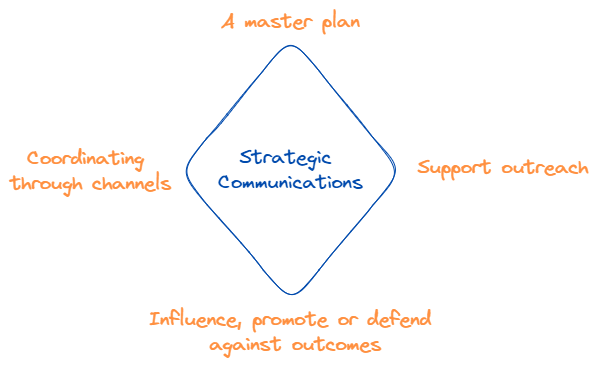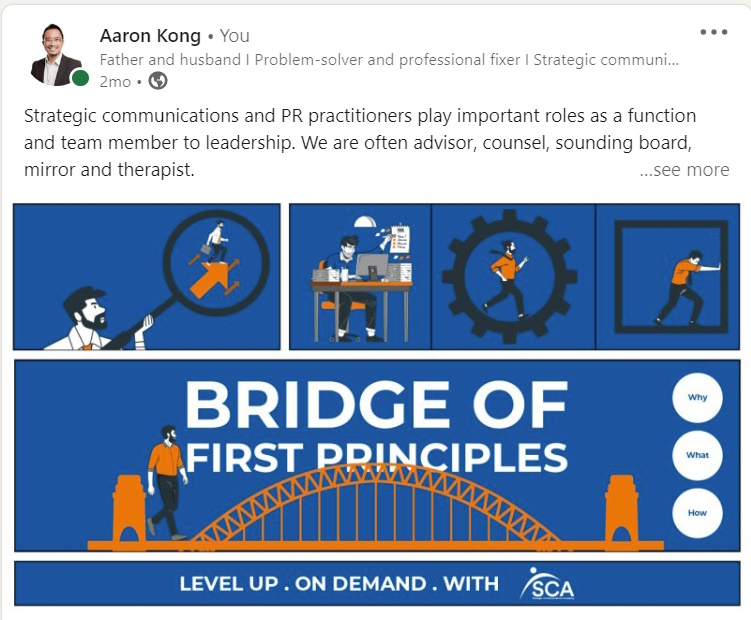Strategic communications and PR practitioners play important roles as a function and team member to leadership.
We are often advisor, counsel, sounding board, mirror and therapist.
When we have clutter, and lack clarity, or confidence, our counsel is likewise impacted.
We stick to advice and recommendation that we are comfortable with, that we know can be achieved.
The low-hanging fruit.
Despite being aware that the fruit will deliver lesser value to our organisation.
We forget about the WHY and the WHAT when delivering the HOW to do something.
Let’s dive deeper into what communications and PR is.
In an earlier article, we shared our definition of strategic communications and what it is.
We reiterate. Strategic communications is critical to a business succeeding.
It is about creating and executing against a master plan, by coordinating the various channels of communications an organisation has to support outreach to decision makers and stakeholders and influence, promote or defend against outcomes.
This includes the sum of all actions, content as well as intentions that the organisation puts out, as well as those that it chooses not to.
All of these must be aligned to support the organisation’s goals.

From an organisation perspective, having a ‘master’ communications/PR plan is similar in function and usage to the business plan, or the business strategy roadmap or the master product plan.
Why would you spend resources on the other plans, and not have one for PR?
With and for all these documents, the central premise is to take think through, place and arrange sequentially all the decisions, steps, and tasks required to achieve a business objective or milestone.
The plan shares the story, narrative, positioning and messaging that the business/brand wants to be recognised for.
It decides between a number of channels that the business/brand has access to, and wants to use in order to achieve the objective.
This plan can even map out the intentions (alongside rationale) of stakeholders that will be taken, when reaching out to decision makers, customers, and stakeholders in order to influence, promote, and defend the brand and the outcomes.
Why is communications/PR still effective in our hyper-connected, attention-saturated environment?
In one word. Reputation.
In more than one word. Credibility earned through reputation.
The Communications/PR function typically aligns and integrates efforts across the brand, regardless of the organisation being a 5-person show or a corporation.
With alignment, there is lesser chance for work to take place in silo, or worse, sabotage the efforts of the larger group.

What can sabotage do?
At the minimum, it can create confusion for the customer, leading them to find simpler alternatives in the arms of competition, resulting in negative impact to both reputation and revenue.
At its worst, customers actively choose and prefer competitors, with no consideration given for the brand. Without an active customer pipeline/flow, revenue dries up and the business fails.
Is PR a secret art? Is it a craft that only communicators know its efficacy?
For a long period of time, PR was used ineffectively as ‘air cover’ and a ‘smoke screen’ or a way to generate ‘feel good’, self-congratulatory activities. Unfortunately, it was also measured the way it was used. This created a negative reputational loop for PR (it was, and still is ironic).
If there is a secret to the craft, it is about learning to respect the different uses of tools that a brand has. No one (should) uses a hammer to screw a nail in, and smashing the area around the nail does not mean the nail is secure.
Find the right tool for the right outcome.
How can I use it to grow my business or brand?
Communications/PR can help build, protect and enhance the value of the brand and its reputation.
The key with Communications/PR is to figure out and agree on the business goal that needs support and decide on how to achieve that goal, alongside other functions/teams.
For example, if your brand sells products that require public infrastructure (perhaps electric vehicles or last-mile electric scooters), a specific communications outcome would be to influence public policy to create more electric charging stations. This would require access to policy makers. To gain access, you would have to provide them with some value, perhaps a white paper, or a research study with a neutral academic, or even an early-stage focus group with paying customers. The steps to get all these activities done will sit in your communications plan.
Here’s another example, if you are a start-up that is bringing in an alternative food product (perhaps millet, or plant-based meat) and you want to validate the product-customer fit prior to launch. That’s what a communications plan will outline. How and where would you find a customer focus group, whether you want to provide media and influencers access or to participate in the group, as well as the mechanics and anticipated outcomes of the group. With the successful execution of this tactic, the brand can use the data to decide on variables such as packaging, promotions, pricing, etc.
Sidebar: Is the pursuit of my craft as a communicator only about supporting the organisation/brand I am with?
Why should you improve your craft? What’s in it for you?
As with any specialist skill, the better you get in an area or niche, you start to differentiate yourself from your peers. This leads to more demand for your skill sets and competencies. Minimally, this situation improves your earning power, and you get to enjoy the positive reputation of being a specialist. This is quite similar to the environment you are building for the organisation/brand you are working for.
Additionally, you get to:
- Develop and build your credibility: This can help you build trust with clients and stakeholders and make it easier for them to rely on your advice and recommendations.
- Expand your network: Building relationships can open up new opportunities for growth and collaboration. By improving your skills, you can build your reputation as a knowledgeable and reliable specialist, which can help you expand your network.
- Increase job opportunities: Organisations are always looking for skilled and knowledgeable professionals, and by demonstrating your expertise, you can increase your chances of landing new opportunities and advancing your career.
But there is a dark side to this pursuit. There are several paths to frustration.
Some key frustrations include learning a new skill but having no opportunity to practice it. The other is to be tasked to deliver on an area but not have the capability to do so due to lack of competency, bad brief/instruction, unrealistic expectations.
There is a solution that is not simple and (definitely) does not make the going ‘easier’ in the future. But it is a solution.
When executed properly, with the right research, framing and context shared, it can open doors to opportunities, expand your mindset and show you the range and depth of our strategic communications craft.
That solution is to train.
If you are looking to train or be trained, we can help you. Set up a meeting with me if you are looking for digital and/or in-person training, or building your organisation/team’s own learning management system: https://calendly.com/strtgcommsgrp/meetingwithaaron
Here are three things you can do immediately to improve your delivery of communications/PR for your organisation
- Market research: Understand the customer, their purchase habits, the channels and media they consume; and see whether your brand can identify a high reward – low risk niche to start from.
- Build and customise the strategic communications plan to niche/country/local environment: Build the goals, objectives, narrative/story, positioning, messaging and localise them for the new market. Be specific. Be clear. Be realistic about outcomes: Plan for activities that will deliver the outcomes.
- Measure constantly (or set up measurements/metrics) in terms of whether an action leads to a sales or a conversion. If the data shows otherwise, recalibrate the strategic communications plan and move along the new direction.
Here is one long-term action you can work on that will bring dividends to your communications function/team/activity over the next 6 – 9 months.
Get to know your customers, down to the niche/point of differentiation: Figure if there are low-risk means of engaging with these customers. Incorporate feedback from the engagement with these customers. Continually re-engage with a larger and wider group of niche customers until there is clear consensus of the positive value received with your product or service. Update your positioning/messaging to reflect the value delivered to the customer.
I provide communications and PR solutions for organisations and practitioners through counsel, consultancy and training. With over 20+ years in the industry, we have created frameworks, methods and content that enable you and your team to launch, grow, level up and earn revenue effectively and efficiently.
Here are 3 ways I can help communications, marketing and PR practitioners:
- Consultancy and enablement: My team can support brands with lean and growing teams as a plug-and-play strategy and execution solution that delivers business outcomes relating to revenue, entry, scale, and expansion.
- Workshops and Digital courses: We train practitioners in-person and a cloud-based learning management platform on topics such as project management, stakeholder management and on PR skills such as writing, creating and measuring outcomes, campaign execution, media relations, issues management, and crisis communications. Training is done through the academy – alongside other experienced trainers – with a focus on levelling up practitioners’ skill sets, competencies and personal development by taking their craft to the next level.
- Custom LMS: My team builds custom LMS solutions for your learners, providing an interactive platform and adapting your organisation’s specific methodologies into the learning content.
Set up a meeting with us if you are looking for to deliver growth outcomes for your organisation, brand or team.
And subscribe to join over 1,500+ communicators and brands getting value every Tuesday while reading A Communicator’s Perspective, our weekly newsletter.

